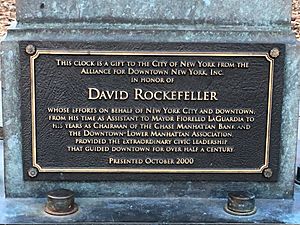David Rockefeller facts for kids
Quick facts for kids
David Rockefeller
|
|
|---|---|
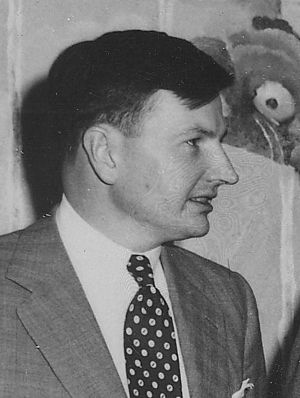
Rockefeller in 1953
|
|
| Chairman of the Council on Foreign Relations | |
| In office 1970–1985 |
|
| Preceded by | John J. McCloy |
| Succeeded by | Peter George Peterson |
| Chairman and CEO of Chase Manhattan Bank | |
| In office 1969–1981 |
|
| Preceded by | George Champion |
| Succeeded by | Willard C. Butcher |
| Personal details | |
| Born | June 12, 1915 New York City, U.S. |
| Died | March 20, 2017 (aged 101) Pocantico Hills, New York, U.S. |
| Political party | Republican |
| Spouse |
Margaret McGrath
(m. 1940; died 1996) |
| Children | David Jr., Abigail, Neva, Margaret, Richard, and Eileen |
| Parents | John D. Rockefeller Jr. Abigail Greene Aldrich |
| Relatives | Rockefeller family |
| Education | Harvard University (BA) London School of Economics University of Chicago (MA, PhD) |
| Military service | |
| Allegiance | |
| Branch/service | |
| Years of service | 1942–1945 |
| Rank | Captain |
| Battles/wars | World War II |
David Rockefeller (June 12, 1915 – March 20, 2017) was an important American banker. He was the head of Chase Manhattan Corporation for many years. David was the oldest living member of the famous Rockefeller family for a long time. He was the youngest of six children of John D. Rockefeller Jr. and Abby Aldrich Rockefeller. His grandfather was John D. Rockefeller, who founded Standard Oil.
David Rockefeller was known for his many connections with political leaders around the world. He traveled a lot and met with many foreign leaders. At the time of his death in 2017, his wealth was estimated to be $3.3 billion.
Contents
- David Rockefeller's Early Life
- How David Rockefeller Studied
- David Rockefeller's Career Path
- David Rockefeller's Political Connections
- Groups David Rockefeller Helped Lead
- David Rockefeller's Later Years
- David Rockefeller's Family Life
- David Rockefeller's Wealth
- Where David Rockefeller Lived
- Groups David Rockefeller Led
- Awards and Honors David Rockefeller Received
- See also
David Rockefeller's Early Life
David Rockefeller was born in New York City. He grew up in a very tall, eight-story house. This house was at 10 West 54th Street. It was the tallest private home ever built in the city.
David was the youngest of six children. His father was John D. Rockefeller Jr., a financier. His mother was Abby Aldrich Rockefeller, a socialite. His grandfather, John D. Rockefeller Sr., co-founded Standard Oil.
David had five older brothers and sisters. Their names were Abby, John III, Nelson, Laurance, and Winthrop. He went to the experimental Lincoln School in Harlem.
How David Rockefeller Studied
In 1936, David graduated with honors from Harvard University. While there, he worked as an editor for the student newspaper, The Harvard Crimson. He also studied economics at Harvard for a year. Then, he spent a year studying at the London School of Economics (LSE).
At LSE, he met John F. Kennedy, who later became President. David even dated Kennedy's sister, Kathleen, for a short time. While in London, he worked briefly at the London branch of what would become the Chase Manhattan Bank. After returning to the U.S., he continued his studies. He earned a Ph.D. from the University of Chicago in 1940.
David Rockefeller's Career Path
Working for the Government
After finishing his studies, David worked for New York Mayor Fiorello La Guardia. He served as a secretary for 18 months. He worked for a very small salary, just "a dollar a year." The mayor told the press that David was one of 60 interns. But David's office was the vacant office of the deputy mayor. From 1941 to 1942, he was an assistant director. He worked for the U.S. Office of Defense, Health and Welfare Services.
Serving in the Military
David Rockefeller joined the United States Army in 1943. He went to Officer Candidate School. By 1945, he was promoted to Captain. During World War II, he served in North Africa and France. He spoke French very well. He worked for military intelligence, setting up units to gather information. He was part of a secret unit called the "Ritchie Boys." For seven months, he was an assistant military attaché in Paris. He used his family contacts to help with his work.
His Time in Banking
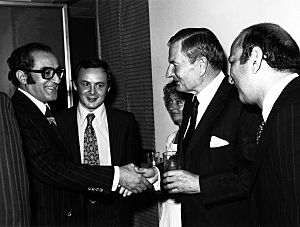
In 1946, David joined the Chase National Bank. This bank had long ties to his family. His uncle, Winthrop W. Aldrich, was the chairman at the time. Chase Bank mainly worked with other big banks and large companies. For example, it worked with General Electric. The bank also had strong connections to the oil industry. It worked closely with companies that came from Standard Oil.
Chase National became Chase Manhattan Bank in 1955. It then started to focus more on banking for regular people. Today, it is known as JPMorgan Chase.
David started as an assistant manager in the foreign department. He helped finance international trade. This included things like coffee, sugar, and metals. He managed relationships with over 1,000 banks worldwide. He moved up in the company and became president in 1960. From 1969 to 1980, he was both chairman and chief executive of Chase Manhattan. He remained chairman until 1981. In 1980, he was the bank's largest individual shareholder. He owned 1.7% of its shares.
Under his leadership, Chase grew internationally. It became a key part of the world's financial system. This was because of its huge global network of banks. In 1973, Chase opened the first branch of an American bank in Moscow. This was in the Soviet Union at the time. That same year, Rockefeller visited China. This led to Chase becoming the first U.S. bank to work with the National Bank of China.
During his time as CEO, the bank faced some challenges. Some people criticized him for spending too much time abroad. The bank had more loans that were difficult to collect than other big banks. In the mid-1970s, Chase owned many New York City bonds. This was when the city was close to going bankrupt. By 1981, the bank's finances were healthy again.
In 1979, David Rockefeller was involved in a big international event. He and Henry Kissinger helped persuade President Jimmy Carter to let the Shah of Iran, Mohammad Reza Pahlavi, come to the U.S. for medical treatment. This decision led to the Iran hostage crisis. For the first time, Rockefeller received a lot of attention from the media.
He retired from managing the bank in 1981. His successor was Willard C. Butcher.
David Rockefeller's Political Connections
David Rockefeller traveled widely and met many world leaders. He met U.S. presidents, starting with Dwight D. Eisenhower. Sometimes, he acted as an unofficial messenger for high-level business. Among the foreign leaders he met were Saddam Hussein, Fidel Castro, Nikita Khrushchev, and Mikhail Gorbachev.
In 1968, his brother Nelson Rockefeller, who was governor of New York, offered him a Senate seat. This was after Robert F. Kennedy was assassinated. David declined the offer. President Jimmy Carter also offered him the job of United States Secretary of the Treasury. He turned that down too.
Some people criticized Rockefeller for being friends with foreign leaders who were autocrats. This was because he wanted to expand Chase's business in their countries. A columnist named David Brooks wrote in 2002 that Rockefeller was loyal to members of his "club," no matter what they did. He noted that Rockefeller made deals with "oil-rich dictators" and "Soviet party bosses."
Rockefeller met Henry Kissinger in 1954. He later named Kissinger to the board of the Rockefeller Brothers Fund. They often talked about important issues. Rockefeller supported Kissinger's idea of "opening of China" in 1971. This created new banking opportunities for Chase Bank.
He was a lifelong member of the Republican Party. He was part of the moderate "Rockefeller Republicans." In 2006, he helped form a group called Republicans Who Care. This group supported moderate Republican candidates.
Ties to the CIA
Rockefeller knew Central Intelligence Agency (CIA) director Allen Dulles. He also knew Dulles's brother, John Foster Dulles, who was Secretary of State. Allen Dulles set up his WWII operations center in Rockefeller Center. He worked closely with MI6, the British intelligence agency.
David Rockefeller was also friends with former CIA director Richard Helms. A former CIA agent said that David was often told about secret intelligence operations. This was done under the direction of his "friend and confidant," CIA director Allen Dulles.
Groups David Rockefeller Helped Lead
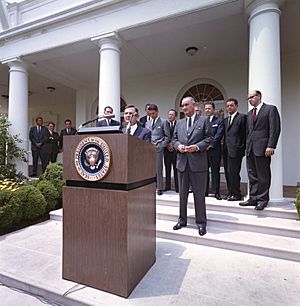
In 1964, David Rockefeller helped start the International Executive Service Corps. This group helps developing countries grow private businesses. In 1979, he created the Partnership for New York City. This is a group of New York business people. In 1992, he was chosen for the Russian-American Bankers Forum. This group advised Russia on how to improve its banking system.
Rockefeller was involved with the Council on Foreign Relations (CFR) since 1949. In 1965, he and other business leaders formed the Council of the Americas. This group aimed to support economic cooperation in the Americas. In 1992, Rockefeller suggested a "Western Hemisphere free trade area." This idea became the Free Trade Area of the Americas in 1994.
He also helped create the Trilateral Commission in 1973. This group aimed to include Japan in important international discussions.
David Rockefeller's Later Years
After World War II, David became more involved in his family's businesses. He worked with his brothers in their family offices at Rockefeller Center. They called this place "Room 5600." They worked to organize the family's many business and charity projects. The brothers held regular meetings to make decisions. David kept notes of these meetings.
After his brothers passed away, David became the main head of the family. He made sure that younger family members, called the cousins, got involved. He invited them to be active in the Rockefeller Brothers Fund. This was a main charity started by the five brothers and their sister in 1940. The wider family also started their own charity, the Rockefeller Family Fund, in 1967.
In the 1980s, there was some discussion about Rockefeller Center. In 1985, the family took out a mortgage on the property. In 1989, 51 percent of the property was sold to a Japanese company, Mitsubishi Estate Company. This was later increased to 80 percent. Some people criticized this for selling a major U.S. landmark to foreign interests. In 2000, Rockefeller oversaw the final sale of Rockefeller Center. This ended the family's direct financial connection to the center after more than 70 years.
David Rockefeller was a generous giver. In 2005, he gave $100 million to the Museum of Modern Art. He also gave $100 million to Rockefeller University. These are two important family institutions. He also gave money to Harvard University and Colonial Williamsburg. In 2006, he promised $225 million to the Rockefeller Brothers Fund after his death. This was the largest gift in the Fund's history. This money would support projects for health care, research, fighting poverty, and sustainable development. It would also help create talks between Muslim and Western nations. In 2008, he donated another $100 million to Harvard University.
The New York Times estimated in 2006 that he had given $900 million to charity in his lifetime.
In 2002, he published his book, Memoirs. This was the only time a Rockefeller family member wrote their own life story. David Rockefeller was known for supporting international cooperation.
His will stated that after his assets were sold, over $700 million would go to various non-profit groups. These included Rockefeller University, the Museum of Modern Art, and Harvard. The largest donation would launch the David Rockefeller Global Development Fund.
David Rockefeller's Family Life
In 1940, David Rockefeller married Margaret "Peggy" McGrath. She passed away in 1996. They had six children:
- David Rockefeller Jr. (born 1941) – He is involved in many family organizations.
- Abigail Aldrich "Abby" Rockefeller (born 1943) – She is an ecologist and feminist. She was interested in environmental issues and supported the women's liberation movement.
- Neva Rockefeller (born 1944) – She is an economist. She is a director and vice chair of the Rockefeller Brothers Fund.
- Margaret Dulany "Peggy" Rockefeller (born 1947) – She founded the Synergos Institute. She is also on the board of the Council on Foreign Relations.
- Richard Gilder Rockefeller (1949–2014) – He was a doctor. He was chairman of the U.S. advisory board for Doctors Without Borders.
- Eileen Rockefeller (born 1952) – She is the founding chair of Rockefeller Philanthropy Advisors.
His Passing
David Rockefeller passed away peacefully in his sleep on March 20, 2017. He was at his home in Pocantico Hills, New York. He was 101 years old.
David Rockefeller's Wealth
When he died, Forbes magazine estimated his wealth at $3.3 billion. Much of his wealth came from family trusts. These trusts held shares in companies that came from Standard Oil. He also had investments in real estate. For example, he owned parts of the Embarcadero Center in San Francisco. He later sold these for a good profit. He also owned a resort in the Virgin Islands, a cattle ranch in Argentina, and a sheep ranch in Australia.
Another big part of his wealth was his art collection. It included art from impressionist to postmodern styles. His mother, Abby, helped him develop this interest. She also helped start the Museum of Modern Art in New York City in 1929. His art collection was worth hundreds of millions of dollars. It was sold in 2018. The money went to several non-profit groups. These included Rockefeller University, Harvard University, and the Museum of Modern Art.
Where David Rockefeller Lived
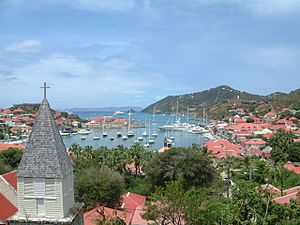
David Rockefeller's main home was "Hudson Pines." This was on the family estate in Pocantico Hills, New York. He also had a home in Manhattan. He owned a country home called "Four Winds" in Livingston, New York. There, his wife raised Simmenthal beef cattle. He also had a summer home in Seal Harbor, Maine. In 2015, he donated one thousand acres of land there to a local preserve.
He owned a large estate on the French island of Saint Barthélemy. He was one of the first people to develop and visit the island in the 1950s. His home was very modern and located in the Colombier area. This area is known as one of the most beautiful on the island. The property is the largest private land on the island. It covers the entire Baie de Colombier. The Rockefeller family donated land to create the Saint Barth "Green Zone." This is an area where no building is allowed.
The property included a private dock in the port of Gustavia. There were no roads to the property. The only way to get there was by boat. David Rockefeller would dock his yacht in Gustavia. Then he would take a smaller boat to the Colombier estate. The bay was too small for his yacht. The property was recently listed for over $100 million. It is not currently used as a home. The main house has fallen into disrepair.
The Kykuit part of the Rockefeller family compound is home to The Pocantico Conference Center. This center was started by David and his brothers in 1940.
Groups David Rockefeller Led
- Council on Foreign Relations – Honorary Chairman
- Americas Society – Founder and Honorary Chairman
- Trilateral Commission – Founder and Honorary North American Chairman
- Bilderberg Meetings – Member of the Member Advisory Group
- The New York Young Republican Club – Board Member
Awards and Honors David Rockefeller Received
- Presidential Medal of Freedom (1998);
- U.S. Legion of Merit (1945);
- French Legion of Honor (1945);
- U.S. Army Commendation Ribbon (1945);
- Commander of the Brazilian Order of the Southern Cross (1956);
- Elected to the American Philosophical Society (1959);
- Charles Evans Hughes award NCCJ, (1974);
- Elected to the American Academy of Arts and Sciences (1991);
- George C. Marshall Foundation Award (1999);
- Andrew Carnegie Medal of Philanthropy (2001);
- Synergos Bridging Leadership Award (2003);
- The Grand Croix of the Légion d'honneur (2000);
- C. Walter Nichols Award, New York University (1970);
- World Brotherhood Award, Jewish Theological Seminary of America (1953);
- Award of Merit from the American Institute of Architects (1965);
- Medal of Honor for City Planning, American Institute of Architects (1968);
- World Monuments Fund's Hadrian Award (for preserving art and architecture) (1994);
- National Institute of Social Sciences Gold Medal Award (1967 – given to all 5 brothers);
- United States Council for International Business (USCIB) International Leadership Award (1983);
- The Hundred Year Association of New York's Gold Medal Award (1965).
See also
 In Spanish: David Rockefeller para niños
In Spanish: David Rockefeller para niños


